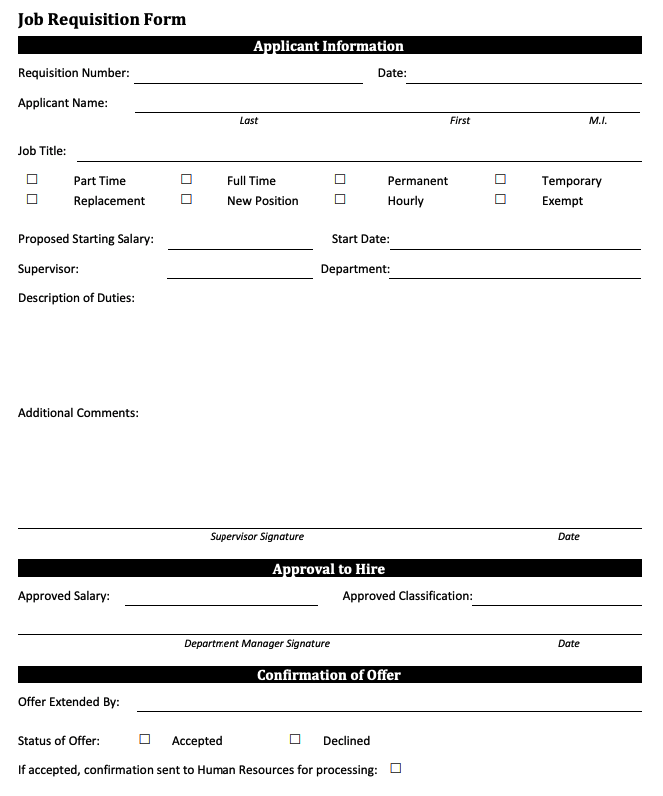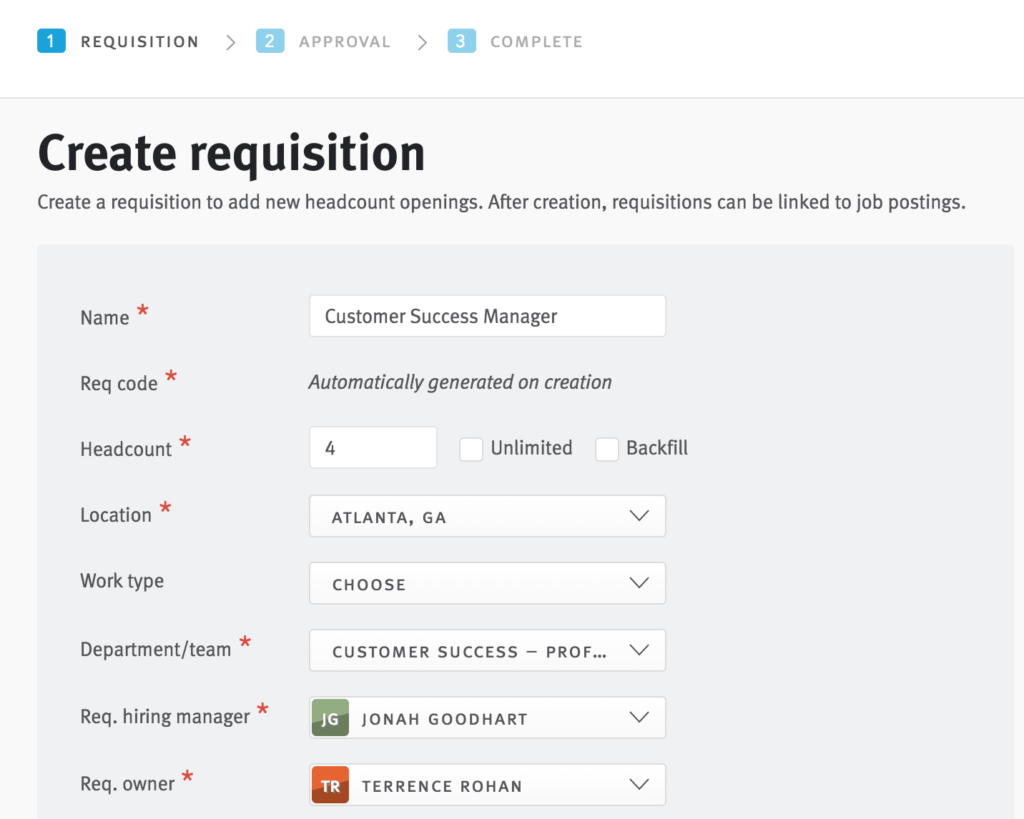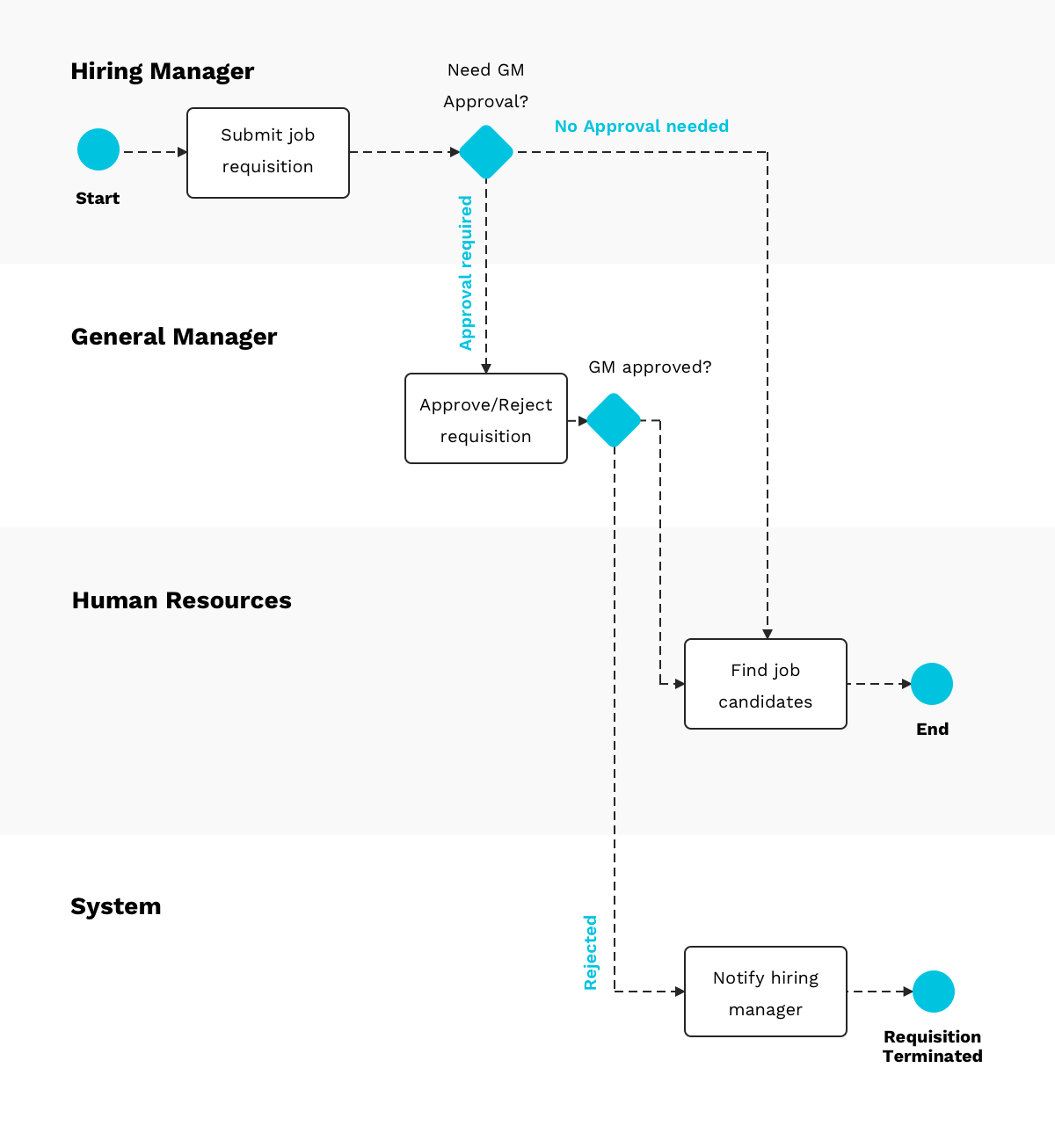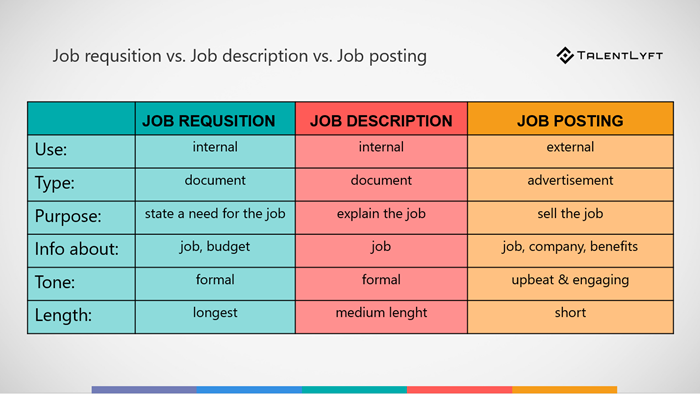Job requisition is an essential step in the hiring process.
Not only does it help businesses prioritize their hiring needs, streamline the recruiting process and make better choices, but it can also act as a checks and balances system.
Implementing job requisitions into the hiring process means recruiters will have a clear idea about what type of job role they need to fill, a start date, a proposed salary band, and the contract type.
This piece will take a deeper look at what exactly job requisitions are, why you need them, and how to make sure you’re writing good job requisitions.
Let’s dive in.
What’s in?
- What’s a job requisition?
- What does a job requisition include?
- Why do you need a job requisition?
- The job requisition process
- Job requisition vs job description vs job posting
- How to write a good job requisition
Like what you see?
Don’t miss out. Subscribe to our quarterly digest to get the latest TA and TM resources delivered right to your inbox.
What’s a job requisition?
A job requisition is a way of formalizing a hiring need. It gives recruiters or managers an explanation of why the role needs to be filled along with other crucial information to make the right hiring decision, serving as a foundation for your job postings and recruiting process.
Job requisitions often lay out what type of role needs to be filled in what department, along with a salary band, start date, job description and if a bonus will be available. A requisition is then sent out to management for approval. It will give them a blueprint of what they can offer candidates when the hiring process begins.
Usually, job requisitions are created in two ways, either in a form or on an Applicant Tracking System (ATS). If your company uses an ATS, it will likely have templates ready to use to create the reqs quickly and easily, plus tools to manage the job requisition approval process further.
What does a job requisition include?
A job requisition will include some standard elements, such as what department is hiring, a salary band, and whether it’s a full-time, part-time, or temporary position.
Key elements to any job requisition usually include:
- Department: What department/team you’re hiring for
- Manager/recruiter: Whoever is in charge of making the hire
- Reason for requisition: Why are you hiring for the role? Is it a new position in the department, or is it to fill an existing employee who has retired or left the company?
- Salary band: An expected salary range the recruiter can offer applicants during the interview process
- Start date: A proposed start date for the role
- Contract: If the contract is for a full-time, part-time, or temporary role as well as how many hours a candidate will be expected to work per week
- Employment qualifications: If you need a certain skill set or length of experience to fill a role. For example, if the job requires a certain degree or qualification, it will need to be listed on the job requisition
- Budget/timeline: If you need a position filled quickly, or if you only have a set amount of funding to spend recruiting, this needs to be included on the form. That way, the manager/recruiter has some indication of a timeline they need to have the position filled by, as well as how many hours they can dedicate to the search
- Job description: A detail description of tasks and duties of the role, gained through a thorough job tasks analysis
A standard job requisition form usually looks something like this:

If you’re using an ATS, you’ll likely be given a template where information can be filled in and submitted digitally directly within the platform, like in this job requisition example from Lever:

Why do you need a job requisition?
Integrating job requisitions into your hiring process is crucial.
Not only can they justify the need for the role within the organization and formalize the beginning of hiring for a new role, but they also clearly outline the needs of a department to a hiring manager or recruiter. Remember that if you are outsourcing recruiting, or you have large departments, it’s almost impossible for those in charge of a hire to know details like salary bands or education qualifications needed for a role unless you outline them.
Job requisitions cover these bases, as well as giving recruiters an explanation of why you need this hire and what you expect a candidate to bring to the table.
It can also help companies to formalize their recruitment processes. By putting their hiring needs in writing before searching for candidates, job requisition forms can keep a paper trail of what managers expect from candidates as well as how long hires take, and why the position needs to be filled in the first place.
For example, if departments are constantly hiring for new positions because employees are leaving for other roles, it might highlight that they have a problem with churn that needs to be looked into.
Job reqs are also an excellent way for HR departments to build a transparent recruitment policy and measure their recruiting KPIs.
As Recruitee’s Bev Campling explains, tracking recruitment KPIs allows businesses to monitor the number of new job requests they create as well as give an insight on time to hire and time to fill.
“This allows hard to fill positions to be identified,” she says.
“Hiring costs can also be tracked from reqs by comparing these metrics with the number of hours put in by recruiters. HR can then easily calculate whether they’re over or under-staffed.”
Tracking all of these metrics not only makes it easier to document your hiring process, but it allows you to set expectations for everyone involved. If a job needs to be filled in a specific department, these metrics will give you an indication of how long it should take to fill and how much it should cost to bring a new hire on board.
The job requisition process
If a job vacancy needs to be filled, the first port of call is an alert raised by a hiring manager or recruiter.
It is up to them to create and complete a job requisition before the hiring process starts. Once they gather information from the relevant department about the job, if the vacancy is in a larger company, the hiring manager will then need to send the job requisition to the HR and/or finance department for approval.
Like any part of the modern hiring process, this is where tech can make the process a lot easier.
If your organization is using an ATS, then a lot of the job requisition process can be automated. From the beginning of the process, an ATS can use predefined rules to automatically move along the job requisition in between departments for approval.
For example, larger companies may require the HR department and the finance department to sign off on a job requisition. An ATS can automatically move it between apartments after approval and then deliver it back to the hiring manager once everyone has given it the ok.
After it is signed, the hiring can begin. Think of a job requisition as the very first step of the hiring process.

This is what a typical job requisition approval process looks like in many companies. There might be some differences, e.g. approval from the finance manager.
Job requisition vs job description vs job posting
It’s important not to confuse job requisitions with job descriptions or job postings.
Although it’s common for the three terms to be used interchangeably, there are some differences to note:
- Job requisitions: Are only used internally by hiring managers and HR/Finance departments. Candidates who apply for the job will never see this form.
- Job descriptions: Are also internal documents, but they are used by recruiters to create job advertisements. The reason these are important is that companies must communicate job openings in a tone that reflects the company’s messaging and style. These internal documents give recruiters a guide on what type of language they should use to describe a job position and the responsibilities/qualifications a candidate should hold if they want to apply
- Job postings: This is what a candidate will see before they apply for a job. It is the result of what a hiring manager writes as a job advertisement using the information given to them in the job description.
There are also more nuanced differences between the three terms, like tone and length:

How to write a good job requisition
1. Be thorough and convincing
The first step to writing a good job req is to convince the HR or finance department why a role needs to be filled and how it will impact the team.
To do this, the job requisition needs to be thorough and convincing enough to get the role approved so you can begin with the hiring process. Not only should it align with the company goals and vision, but it should also create a sense of urgency of why a hire should be made sooner rather than later.
It should also focus on what the new hire will achieve in the role, and what’s at stake if the company fails to fill it:
- What tasks/projects will you risk going unfinished if the role isn’t filled?
- If the person who is leaving/retiring from the role had a certain skill set, why is it essential that a new hire also has similar skills?
- What will happen to the department if the role isn’t filled?
- How will it affect the company’s customers if the HR department decides not to replace the employee?
Each question the job requisition asks and answers should tie back to convincing the departments reading it that hiring a person for the role is important.
You also need to be detailed in your describing the duties of the role. That way, you can use the job requisition to create great job postings that will attract a diverse candidate pool.
2. Be realistic
Next, you must be realistic about the finer details of the job role.
- What is the budget?
- When do you need a new hire to start?
- What qualifications must they hold?
- What days must they be available to work?
If you make sure the details are realistic and reflect the nature and tasks of the job, it will make the entire hiring process easier. Not only will it make the job description and posting more accurate, but it will also help with a candidate’s job fit during the interview process.
3. Get management support
Finally, you need to get management on board with making this hire a reality.
Part of this is making sure your job requisition is convincing and highlights the positive contribution this person will bring to the team and the organization. The other part is to make it as easy as possible for the departments involved to say yes and put their stamp of approval on the job requisition.
Think about it. If you can make a clear argument for why the role is needed and exactly how much it will cost, then it’ll be harder for other departments to push back against going ahead with the hire.
If your company can afford it and it’s clear the person hired for the role will be beneficial to the company and its bottom line… who is going to say no?
Wrapping up
A well-written job requisition is well beyond just a formality in the hiring process.
It can also kickstart a successful hire, from making sure the role is needed, and the company can afford it right down to aligning the job advertisement to the company’s tone of voice and designing a recruiting process that will result in the best possible hiring decision.
Using job req gives everybody—from recruiters to HR managers to the finance department—a clear understanding of what the role will be, how much it will cost, and when the new person will be starting.
Having all of this information available before the recruitment process starts allows you to tailor your sourcing and recruiting strategy and ensure a fair, consistent hiring process.


